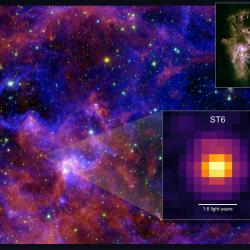Astronomy Associate Research Scientist Patrick Whelley Answers Questions About the Moon
The College of Computer, Mathematical, and Natural Sciences hosted a Reddit Ask-Me-Anything spotlighting research on the moon's composition.

University of Maryland Astronomy Associate Research Scientist Patrick Whelley participated in an Ask-Me-Anything (AMA) user-led discussion on Reddit to answer questions about the moon on July 11, 2024.
A geologist and geomorphologist, Whelley has traveled the world seeking to understand how volcanoes on Earth can help explain volcanic physics on rocky moons and planets. Whelley also recently served as the field safety officer for NASA’s test mission ahead of the Artemis II and III missions.
This Reddit AMA has been edited for length and clarity.
What is a fact about the moon that someone who knows very little would enjoy?
The moon has volcanoes on it, and you can look at evidence of this by yourself. When you go out at night and look at the dark patches of the moon, those are billion-year-old lava patches on the moon that you can still see with your naked eye today. These are called maria patches, and they're made of basalt (the same kind of lava that erupts in Hawaii).
How do you think ore geology might differ between the moon and Mars? Naturally, the moon is going to lack a lot of surficial/sedimentary stuff, but is the geochemistry similar enough for the moon to develop magmatic ores as we get at hotspots or old cratons? Did Mars have any felsic-enough volcanism to get anything like the hydrothermal deposits we get along plate boundaries on Earth?
A lot of the ore that is valuable for mining on Earth is related to plate tectonics and metamorphic rocks (rocks that are smashed and buried, then brought up to the surface by tectonic processes). So those wouldn't be on the moon or Mars.
Plate tectonics on Earth is really efficient at recycling the crust; our planet has erased lots of old impact craters, but billion-year-old impact craters that could have valuable ore still exist on the surface of the moon and Mars. Most of the volcanic material on Mars is more basaltic and not very felsic. But we're discovering new kinds of volcanism all the time.
If you could choose where the next NASA probe goes (and lands), where would you send it?
I would like to see a lava tube on the moon. That would be a new environment on the near subsurface of the moon, and it could hold water ice, and other stuff that hasn't seen the sun ever. I think that's really exciting to think about what we could find in a lava tube on the moon, but it would be really hard to do that. While it likely won't be the next probe, we could send a probe into a lava tube in the near future.
Assuming that Earth and the moon are of the same source, there should be more or less the same material. And since the moon lost all lighter elements due to low gravity is it possible to assume there could be a lot of rare Earth materials on the moon. The moon probably lost a lot of water and other volatiles in the impact. It turns out the Earth and the moon have very similar populations of oxygen, silica, iron and other materials that compose rocks.
If you could have a 1-kilogram rock sample from any location on the moon to study, where would you want it from?
The South Pole-Aitken basin is where Artemis III is going to go, and the mission will retrieve a sample from one of the earliest impacts of the moon. This should help us better understand the early history and evolution of the moon.
I'd also like to see a sample from one of the irregular mare patches because they look so strange and the theories for how they formed are all over the place.
I'm curious about the challenges of simulating lunar gravity on Earth. How do you overcome the significant difference in gravitational force? How does it impact the training of astronauts for lunar missions?
NASA uses a bunch of different systems to simulate lunar gravity for training purposes. We use a pool for buoyancy to offload gravity and compensate for Earth's gravity. There's also a pully system that's used for some tests. We use lighter space suits or tools in the field outdoors on Earth to simulate lower gravity. But no system is perfect, and there's not really a substitute for going to the moon to really experience what it's like.
What was it like getting a job with NASA? How competitive was it and how did you prepare?
I love my job. I get to do some pretty exciting things. Getting funding to do basically anything is super competitive, and so I prepared with geology degrees (bachelor's, master's and Ph.D.), always following interesting questions and always maintaining a dynamic network of people doing challenging things.
Are there any big unresolved questions about the moon from a geology standpoint?
Several come to mind. How much water ice is on the surface of the moon? We should have a much better understanding of this after Artemis III. When did the magnetic field go away? This will help us understand how planetary cores work and how the interiors of planets and moons affect the surface. When was the last volcanic eruption on the moon? This will help us understand the lower crust and the interior dynamics of the moon.
China recently returned the first-ever soil samples from the far side of the moon. Is soil from the far side expected to be different from other samples collected, and if so, why?
The far side of the moon isn't protected from impacts by a planet like the near side of the moon is. It probably gets more meteor impacts. It has less lava flows on the surface (maria patches) because there's a planet that's pulling that stuff towards the near side. But the soil itself on the far side is probably very similar to the highlands soil on the near side. We'll find out when we analyze those samples—they're really exciting samples!
I've read that lunar soil is a lot like asbestos. What can be done to mitigate potential harm to future astronauts who may stay there for long periods?
Dust is a problem for surface operations on the moon. The engineers making suits and tools and life support systems are all working on ways to keep the dust out of the places that the astronauts will be living in. They're doing this with studies about static electricity and with air locks on the lander and all kinds of dust mitigation technologies (some new and some that are the same kinds we'd use to keep a laboratory clean on Earth). It's going to take a combination of all these things to keep astronauts safe and the dust out of their living quarters.
Are there regions of the moon with significantly more lava tubes than others? If so, what is it about those regions that caused them to have more?
There are a lot of things on the moon that we think are lava tubes, called sinuous rilles. To have a lava tube, you need to have a lava flow, it needs to be in a relatively flat area, and it needs to have collapsed a little bit for us to be able to see it. But with geophysics, we're looking for lava tubes that are buried and don't necessarily have a surface expression. What we know right now is that maria patches have lava tubes, but the highlands do not. The GEODES team at UMD is working on methods for finding lava tubes in more places.
Do you think any other planet has experienced a super-volcano event at some point in time? If it has, what do you think the planet was like before, and how did the eruption change it after the ash settled?
Mars does seem to have had super-eruptions in the ancient past. Some of the material in the northern hemisphere is clay minerals that are evidence of volcanic material involved in a very large and explosive eruption. I think there's enough of it for a whole bunch of super-eruptions to have happened on the surface of Mars a few billion years ago.
The eruption probably affected the climate (as it would on Earth), cooling the surface for a few decades or centuries.
What are the biggest current challenges in the way of applying what you learn about the moon to geology questions on Earth and vice versa?
Water and microorganisms are almost everywhere on the Earth. We have to ask the right questions and find the best locations on Earth to study bigger-picture processes so that we can apply what we learn on Earth to the moon. Finding these geologic analogs can be challenging because we have to either ask questions that see through the impact of water and microorganisms or questions that are so different from the impacts of water that we can still learn something.
How do you simulate the jagged sharp moon dust/sand?
The rocks on the moon are very similar to rocks on Earth—the dark patches are basalt and the light patches are anorthosite. Basalt is one of the most common rocks on Earth, and anorthosite is found in a few places, including the Adirondacks in New York. I'm not sure how it's made, but NASA starts with materials on Earth and turns them into materials with the same physical properties as lunar soil sampled by the Apollo astronauts.
What will going to the moon do to help our species practically in the next decade and in the more distant future?
These really hard goals in planetary science push the development of new technology. This could be scientific instruments, spacecraft/aerospace engineering, or new ways to use materials on the planet/moon we're exploring. We're learning a lot about how to travel in space and explore other planets. Some of that will result in new technologies everyone can use, and some of that will result in making space travel more accessible to more people. All of that is really exciting and makes the work more fulfilling.







